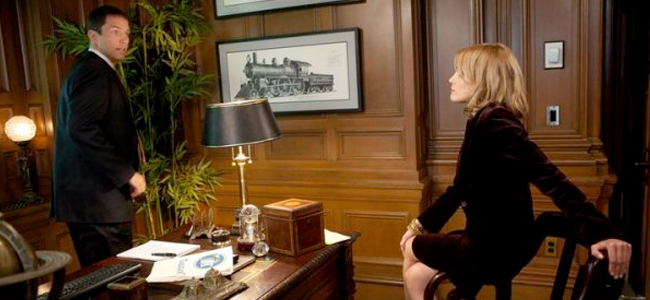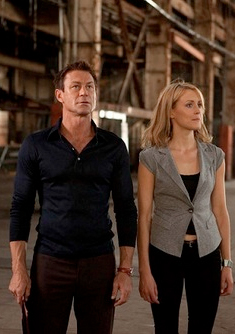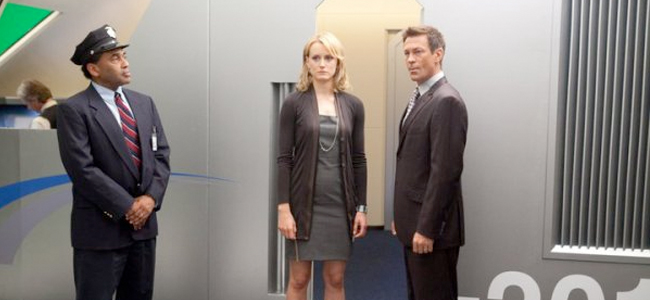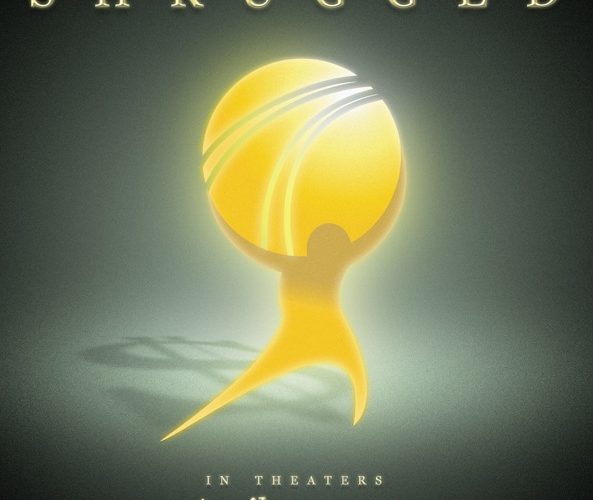
Producers, directors, representatives and even cast members typically bond, one way or another, during the overall production process. Whether the film takes 14 months from concept to delivery, or, in the case of Atlas Shrugged: Part 1, forty years, filmmakers typically pride themselves on the space between.
In the case of Atlas Shrugged: Part 1, it’s 40 years way too late and unbelievably uninviting. Over time things weather out and get stale. Not only had mold and bacteria formed around the edges of the film before this version’s inception, but it seemed as if a bio-hazard team was moments away from infiltrating the sets and taking away anything and everything in order to protect the dream that once was Atlas Shrugged.
 First published in 1957, the Ayn Rand novel was a well-received allegory concerning a dystopian United States at an unspecific time where leading innovators, ranging from industrialists to artists, refuse to be exploited by society. The novel’s title is a reference to Atlas, a Titan of Greek mythology, who in the novel is described as “the giant who holds the weight of the world on his shoulders.” If he shrugged, of course, the world would falter.
First published in 1957, the Ayn Rand novel was a well-received allegory concerning a dystopian United States at an unspecific time where leading innovators, ranging from industrialists to artists, refuse to be exploited by society. The novel’s title is a reference to Atlas, a Titan of Greek mythology, who in the novel is described as “the giant who holds the weight of the world on his shoulders.” If he shrugged, of course, the world would falter.
Receiving largely negative reviews after its 1957 publication, the novel achieved enduring popularity and consistent sales in the following decades, a manifesto for laissez-faire politics and pure capitalist platforms. It’s safe to say the same will not be said for the film.
The opening scene of Atlas Shrugged: Part 1 consists of a train roaring through the lowlands of Colorado during a night that seems too weary for anything good to happen. Stylistically it’s incredible and frightful, something director Paul Johansson (One Tree Hill) should be proud of. I thought I was in for a wild ride for the next 102 minutes. I could not have been more wrong.
Interwoven into this PG-13 drama/mystery/science-fiction are countless scenes of rough, bleak dialogue that never seem to stay on the track. This soon becomes the tone of the entire film: incomprehensible gibberish. I’m more than willing to give credit to the sound engineers, mixers and operators for their crisp captures. That said, I haven’t a clue in hell what was rolling through John Aglialoro‘s and Brian Patrick O’Toole‘s craniums when they wrote the screenplay. Somebody please have them admitted for a CAT scan ASAP.
Meeting the script mediocrity head-on is production designer John Mott and his vacant style. Many scenes in the film are either too cluttered or severely lacking character. The book is extremely visual, essentially spelling out what needs to be purchased by the art department. Unfortunately, it seems Mott as if relied solely on Cliff Notes.
Remember chemistry class? Did you fail it by chance? Well, if you did do not feel alone, because all of the filmmakers here are in the same camp. There is absolutely no chemistry between the characters, not even a single metabolic drop. Blame it on not enough coverage, rehearsal, etc. The list is long. That said, the actors themselves are terrific, but still unable to escape lazy set-ups and sloppy subplots, most noticeably the romance introduced between Dagny Taggart (Taylor Schilling) and Henry Rearden (Grant Bowler).

On a more upbeat note, Schilling‘s Dagny Taggart is stunning, circumventing her wooden lines with pitch-perfect delivery. The way she composes herself while interacting with fellow cast mates radiates a tired screen, most especially those scenes she shares with Bowler as Henry Rearden. Edi Gathegi playing Eddie Willers and Jsu Garcia, who portrayed Fransisco D’Anconia, did well with their minor roles. Graham Beckel (Brokeback Mountain, L.A. Confidential, Another World) depiction of Ellis Wyatt was also right on the money. For a film having a budget of $15 million the VFX were par, but nothing more. The main piece of VFX comprised a high-speed train roaring through the valleys of Colorado and eventually reaching a bridge in which Henry Readen’s company built. The bridge was constructed through the use of computers and seemed only semi-convincing, mirroring the rest of the film.
Atlas Shrugged: Part 1 attempted to embody the drive of American innovation by using bold characters, yet it fell short on numerous levels. It was neither compelling nor entertaining to watch. I was hyped on the thought that the book was finally being transformed after forty years into a film, yet had my doubts. My doubts won. And if for some idiot reason they end up making the second and third installment, please fasten my head directly to the railroad tracks and redo the entire script. Then, and only then, will this film provide anything remotely related to a worthwhile film.


